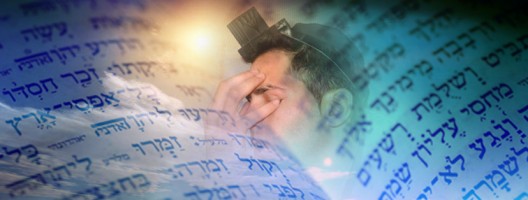The Shema is the ultimate expression of Divine unity. It declares not only that there is one God, but that there is nothing else other than God. God is one and the same as He was before and after the creation of the world, and all that exists is included within God.
The recitation of the Shema is commanded by the Torah, and ought to be done with complete and undivided attention since it expresses the basic principle of Torah—the belief in Divine oneness—and it speaks of the Creator’s relationship with humanity and with our evolving history.
Generally, the Shema is said out loud with the right hand lightly covering the eyes, in order to block out any extraneous distractions, and to help us go inward.
The Shema, says the Talmud, should be recited in “the language you hear,” meaning the language you “know.” This mandate also suggests that whatever you hear—in everything and through everything that you hear—you should sense Divine oneness.
Two letters of the Shema are written extra large in a Torah scroll: the ayin, the last letter of the word Shema (“hear”) and the dalet, the last letter of the word echad (“one”). Taken together, these two letters spell aid, meaning “witness.” By reciting the Shema, we bear witness to the Creator’s oneness.
When the final word, echad, is pronounced, it is drawn out, with each letter distinctly audible. These letters are: alef (which has the numerical value of 1), chet (8), dalet (4). Accordingly, when pronouncing these letters, we should think about the oneness of the Creator permeating the eight levels of creation (the seven heavens and the earth), and the four corners or four dimensions of the world, thus making ourselves aware that all dimensions, as well as time and space, are included in the unity of the Creator. There is also a custom among some when pronouncing echad to move the head slightly—right, left, forward, back, down and up—to indicate that the oneness of God permeates all directions of creation.
The Zohar mentions that when we pronounce the word echad, we should meditate on being willing to give up our life for God, even imagining ourselves being consumed by fire, thus sanctifying God’s name.
Symbolically, when we cover our eyes, we are momentarily, technically blind, and as “the blind is akin to the dead,” so the covering the eyes suggest a death of a sort—a rapture, a state of ecstasy, an expiration of the soul. In the words of Rabbi Eliezer Ezkari, it is as if “one died and is in front of the King.”
In the opening statement of the Shema, plus the short statement that follows (Baruch Sheim), there are 49 letters, corresponding to the 49 gates of understanding, indicating that these passages of the Shema need to be absorbed intellectually, emotionally and ultimately factually.
Comments are closed.







